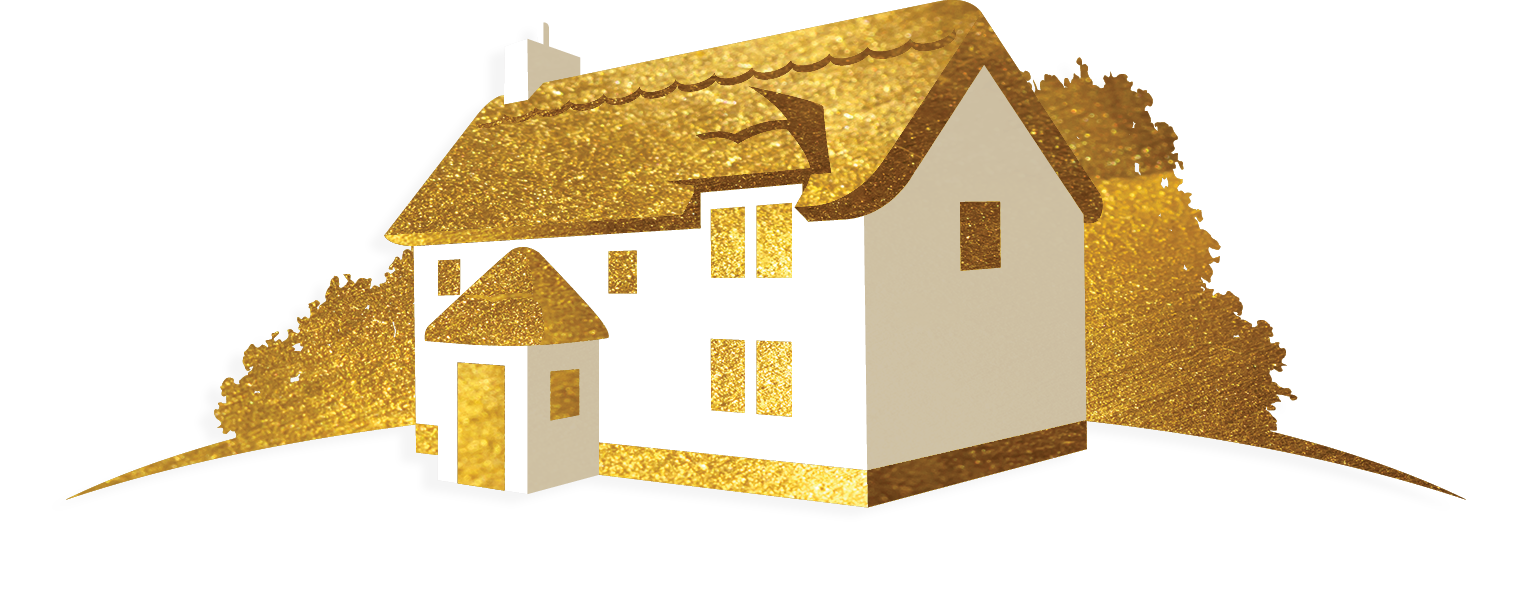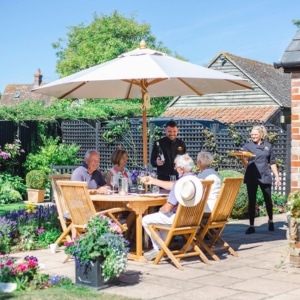Even as we embrace the new year, the festive charm of Christmas lingers in our hearts, inviting a look back at the celebrated traditions that define this cherished time in both the UK and the US. Though the essence of Christmas—centred around joy, family, and giving—unites us all, a comparison of a UK vs. US Christmas reveals distinct differences that add unique flavours to the festivities.
From the timing of celebrations to the special treats that grace our tables, each tradition offers a glimpse into the cultural heart of its people, making the comparison as enriching as it is fascinating. So, without further ado, let’s dive into 10 key differences between UK and US Christmas celebrations!
1. Timing
In the US, the festive period kicks off with Thanksgiving in late November, setting the stage for a month-long anticipation leading up to Christmas Day, December 25th, which is the focal point of the holiday season. This sequence creates a crescendo of celebration, culminating in a single day of joyous gatherings. Meanwhile, across the pond, the UK embraces a more extended festive timeline.
Here, Christmas Day marks the beginning rather than the climax of celebrations, with Boxing Day on December 26th serving as an additional public holiday. The festivities often stretch into the New Year, with the entire period from Christmas Eve to after New Year’s Day enveloped in a sustained atmosphere of cheer. This extended holiday season allows for more days of family visits, public events, and relaxation, embedding the holiday spirit deeply into the British winter.
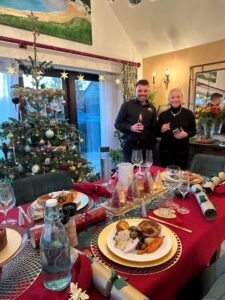
English Cottage Vacation co-host Nathan with a delighted guest at Christmas
2. Christmas Dinner
In the culinary arena, the Christmas dinner table showcases the cultural nuances between the UK and the US during the festive season. In the United States, the Christmas feast is versatile, with turkey, ham, or roast beef serving as the centrepiece, surrounded by a variety of sides from sweet potatoes to green bean casseroles. This flexibility in the main course reflects the diverse culinary traditions across the country.
Conversely, in the United Kingdom, the Christmas dinner is a regal affair with a more traditional menu. The star of the festive British table is often a roasted turkey or a succulent goose, accompanied by an array of sides that celebrate British produce; Brussels sprouts jazzed up with crispy bacon, sweet and tender roast parsnips, and the essential Yorkshire puddings. This meal, steeped in tradition, culminates with the Christmas pudding, a rich dessert that’s been months in the making, doused in brandy and set aflame before serving. The British Christmas dinner, with its customary dishes, stands as a testament to the country’s culinary heritage, making the feast a distinctive and eagerly anticipated part of the holiday season.
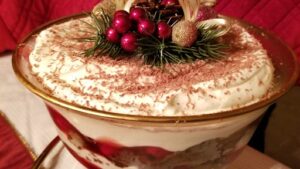
3. Festive Treats
In the realm of holiday indulgence, both the US and UK have their signature festive treats that capture the essence of the season. The US warms the heart with its rich eggnog, delights children and adults alike with creatively decorated sugar cookies, and embraces the architectural marvels of gingerbread houses. These sweet traditions paint a picture of American Christmas, filled with warmth, spice, and everything nice.
Across the Atlantic, the UK’s holiday dessert table tells a story of time-honoured traditions with its own triumvirate of treats. The Christmas pudding, with its rich tapestry of dried fruits and brandy, brings warmth and spectacle to the table, often flambeed to the delight of gathered family and friends. Mince pies, with their delicate pastry encasing a mixture of minced fruits and spices, offer a bite-sized glimpse into centuries of British holiday customs. The Christmas cake, a dense, moist fruitcake cloaked in marzipan and fondant icing, stands as a festive centrepiece, symbolising the richness of the season.
Yet, no discussion of British holiday desserts would be complete without mentioning the trifle. This layered confection, a symphony of sponge cake soaked in sherry or fruit juice, custard, fruit, and whipped cream, crowned with a sprinkle of almonds or chocolate shavings, offers a visually stunning and palate-pleasing finale to the Christmas feast. The trifle, with its layers of flavour and texture, encapsulates the spirit of British culinary extravagance and serves as a beloved reminder of the holiday’s joys and indulgences.
4. Christmas Crackers
In the UK, Christmas isn’t complete without the pop and sparkle of Christmas crackers adorning the festive table. These colourful, twisted tubes, a tradition originating in the 19th century, are an essential part of British holiday cheer. Guests pull them apart with a festive “snap!” to discover paper crowns, which are promptly worn at dinner, along with jokes that range from groan-inducingly bad to genuinely funny, and small trinkets or novelty gifts inside. This delightful custom, which adds an element of surprise and shared laughter to holiday gatherings, is a distinctly British tradition.
Across the pond, however, Christmas crackers are less ingrained in the US holiday customs, making them a unique and charming aspect of a UK Christmas celebration that American guests often find novel and endearing.
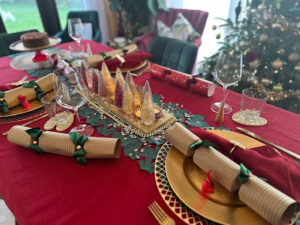
Christmas crackers adorning a sumptuous festive table at Well Cottage
5. Festive Drinks
In the festive beverage department, Americans have long embraced eggnog, a rich, creamy concoction spiked with rum, bourbon, or brandy, as a holiday staple. Mulled cider, another seasonal favourite, offers a warm, spiced alternative that fills homes with its inviting aroma. Across the Atlantic, the British have their own traditional tipple to fend off the winter chill: mulled wine. This spiced, sweetened red wine, often enhanced with cinnamon, cloves, and orange, is a staple at holiday markets and gatherings, embodying the essence of the season.
Moreover, venturing to the local pub on Christmas Day (yes, many are open!) is an ingrained tradition for many Brits, offering a sense of community and festive cheer. Pubs often serve as a warm gathering place where friends and family convene for a traditional meal or a pint, extending the holiday spirit beyond the confines of home. This cherished practice highlights the communal aspect of British holiday celebrations, contrasting with the more home-centred American traditions.
6. Decorations
In the realm of holiday decorations, the US is known for its penchant for the spectacular. Homes transform into luminous displays as elaborate arrangements of lights, inflatable Santas, and reindeers take over yards, drawing both admiration and awe. Some neighbourhoods even engage in friendly competitions, their efforts synchronised to holiday tunes.
Meanwhile, in the UK, the approach to yuletide adornment has traditionally leaned towards the understated, with a focus primarily on indoor decorations such as Christmas trees festooned with baubles, tinsel, and twinkling lights, and mantelpieces adorned with garlands and stockings. However, the trend of outdoor lighting is catching on, with more British homes beginning to embrace the glow of festive illuminations in their gardens and on their homes’ facades, merging a bit of the American flair for the grandiose with their own sense of holiday spirit.
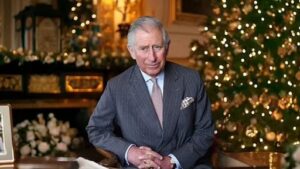
HRH King Charles delivering his Christmas broadcast
7. Royal Address
For many in the UK, one of the most anticipated moments of Christmas Day is the Monarch’s Christmas Broadcast, a tradition initiated in 1932 by King George V and carried forward to the present day. This annual address serves as a reflective moment, offering the Monarch’s insights on the past year, messages of hope, and thoughts on the meaning of Christmas. It’s a time when families, amidst the festivities, pause to gather around their televisions or radios, linking households across the nation in a shared experience of reflection and unity.
The tradition underscores the deep-rooted connection between the British people and the Royal Family, highlighting the Monarch’s role not just as a figurehead but as a source of continuity and moral guidance. Unlike the UK, where this royal message is a central part of the Christmas Day rituals, the United States has no direct counterpart. However, the President often delivers a holiday message, which, while not tied to Christmas Day itself, serves a similar purpose of reflection, gratitude, and forward-looking optimism. These addresses, whether from the Monarch or the President, underscore the broader theme of leadership seeking to connect with and uplift the spirit of the people during the holiday season.
While the contexts and cultural significance of these addresses vary, both the UK’s Royal Christmas Message and the US President’s holiday greetings reflect each nation’s historical traditions and contemporary values, serving as a reminder of the enduring human desire for peace, goodwill, and a sense of shared humanity during the festive period.
8. “Father Christmas” vs. “Santa Claus”
In the heart of the festive season, both the UK and US welcome a beloved figure known for spreading cheer and delivering gifts. Traditionally, the UK’s Father Christmas was depicted in a robe of green, a symbol of the coming spring, embodying the spirit of good cheer and the natural world’s renewal. Over time, influenced by the iconic American image of Santa Claus, created in part by the 1822 yuletide poem “A Visit from St. Nicholas” controversially attributed to Clement Clarke Moore and popularised by Coca-Cola advertising in the 1930s, Father Christmas has come to adopt the familiar red suit. Today, while the names may vary, the essence of this figure remains consistent across cultures, embodying the joy and generosity of the season.
Another subtle yet notable difference lies in the festive greetings. In the UK, the traditional salutation is “Happy Christmas,” a phrase that resonates with warmth and traditional cheer. Across the Atlantic, “Merry Christmas” is more prevalent, echoing through carols and holiday greetings. However, the US has seen a shift towards inclusivity with the adoption of “Happy Holidays” as a common greeting, aiming to embrace all cultural and religious celebrations during this season, reflecting the country’s diverse tapestry of beliefs and traditions.
These variations in terminology and folklore underscore the rich tapestry of cultural nuances that define the holiday season in each country, reminding us that while we may celebrate in slightly different ways, the underlying spirit of joy, community, and goodwill is universally shared.

Father Christmas, aka Santa Claus assessing who’s been naughty and who’s been nice
9. Church Attendance
In the United States, church attendance during the Christmas season is a widespread tradition, reflecting the country’s strong emphasis on religious observance during the holidays. Many Americans find themselves in pews on Christmas Eve or Christmas Day, participating in services that celebrate the birth of Jesus Christ. This practice is deeply ingrained in the holiday culture, symbolising a communal expression of faith and a time for reflection amidst the festive cheer.
Across the Atlantic, the UK presents a more nuanced picture of Christmas worship. While the UK cherishes its historical and cultural ties to Christianity, modern celebrations tend to be more secular. Despite this, Midnight Mass on Christmas Eve retains its allure, drawing people to cathedrals and churches across the country. This candlelit service, often filled with carols and readings, offers a moment of spiritual reflection and peace, standing as a poignant reminder of Christmas’s religious roots.
The contrast in church attendance between the two nations highlights the varied ways Christmas is celebrated and experienced, reflecting broader trends in religious observance and cultural practices.
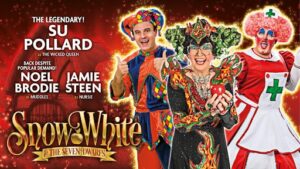
Behind you! A traditional British pantomime billboard
10. Festive Entertainment
In the UK, the pantomime or ‘panto’ is a hallmark of Christmas entertainment, steeped in tradition and beloved by audiences of all ages. These theatrical spectacles are far from the silent performances the term ‘pantomime’ might suggest to American audiences. Instead, British pantomimes are exuberant, interactive comedies incorporating song, dance, slapstick humour, cross-dressing, and audience participation. The stories often revolve around well-known fairy tales or children’s stories, like Cinderella or Aladdin. However, there’s always an amusing twist—incorporating contemporary jokes, local references, and plenty of booing at the villain and cheering for the hero. It’s a festive outing that encapsulates the spirit of British humour and community.
Across the pond, the American Christmas entertainment landscape is rich with performances that evoke the spirit of the season through music, dance, and storytelling. Community theatres might put on productions of Charles Dickens’ A Christmas Carol, bringing to life the tale of Ebenezer Scrooge and his nocturnal journey of redemption, or stage performances of The Nutcracker, a ballet that has become synonymous with Christmas for its magical story and Tchaikovsky’s unforgettable music. These performances, alongside concerts featuring holiday classics like Handel’s Messiah, offer a more traditional take on festive entertainment, inviting audiences to celebrate through the arts. Of course, UK audiences love these shows too!
While the US may not have an equivalent to the raucous joy of a British pantomime, its diverse array of Christmas performances—from ballets to community plays—reflects a similarly deep appreciation for the arts as a means of coming together and celebrating the season. Both countries’ festive entertainments, whether through the interactive fun of pantomimes or the classic beauty of The Nutcracker, highlight the universal desire to connect, celebrate, and be entertained during the holiday period.
UK vs. US Christmas: Final Word
In the grand finale of our exploration between a UK Christmas and a US Christmas, English Cottage Vacation warmly extends an invitation to its serene 18th-century thatched cottage in Dorset, blending traditions to craft your perfect festive retreat. With resident chef Laura at the helm, guests are treated to a culinary journey that weaves together the best of both worlds—from a hearty Christmas dinner to delightful seasonal treats, all tailored to your tastes.
The adventure doesn’t stop at the dining table. Nathan, your dedicated chauffeur and guide, offers tailored excursions across Dorset’s winter landscape, from historic castles to festive markets, ensuring each outing is an exclusive experience. Travel in luxury, uncover the charm of the English countryside, and create new traditions.
A festive holiday at English Cottage Vacation is an invitation to luxury, comfort, and personalised celebration. Whether you prefer the intimate charm of a UK Christmas or the all-out cheer of a US Christmas, or perhaps a unique blend of both, Laura and Nathan are committed to making your stay extraordinary. Here, surrounded by Dorset’s natural beauty and pampered with unparalleled service, your Christmas is set to be memorable, joyous, and tailored to your desires.
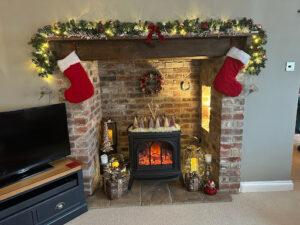
Inglenook fireplace in the cosy snug at English Cottage Vacation’s enchanting Well Cottage
